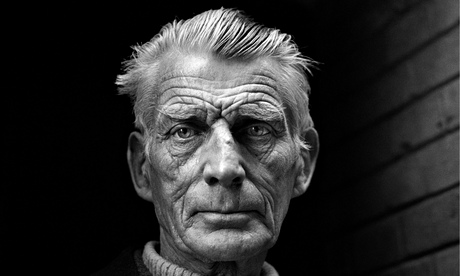
Six cheap dark blue notebooks, sacred relics to admirers of Samuel Beckett, will go on display this week for the first time since an English university paid almost £1m for them at auction. The manuscript of Murphy, the Nobel laureate's first published novel, from 1938, will be on show at Reading University for just one day, before returning to the Beckett scholar who is painstakingly transcribing every crossed-out word, dash and comma. Just one word took him four months to puzzle out: rather disappointingly, it was no gemstone of Beckettian imagination, but "tending".
"These things are valuable, though of course only exciting to sad people like me," John Pilling, a world-renowned authority on the author, said. "It is not his greatest work, but it is the earliest fiction manuscript we have, his first published novel, relatively readable and still funny, and these are precious qualities. It has had a cult following from the start – Harold Pinter stole his copy from Hackney library. And of course Murphy changed my life. I was only 15 when I first read it – a fateful day."
Beckett gave the notebooks to a slightly ramshackle friend, the Irish poet Brian Coffey, who eventually sold them to a collector. They were regarded as one of the most important 20th-century manuscripts still in private hands when auctioned at Sotheby's last year, estimated at up to £1.2m. After seven tense minutes, bidding against an anonymous collector on the phone, the university got them for £962,500.
Since mounting an exhibition in 1969 in celebration of the author winning the Nobel prize, Reading has gradually built up the largest collection of Beckett material in the world, including many gifts from the author before his death in 1989. The one-day exhibition on Wednesday, at the university's Museum of Rural Life – the most accessible secure display space – will be the first time the notebooks have ever been on show.
They reveal that the novel, where the central character gets a job in a mental hospital as a blessed escape from the madness of his life in London, was originally called Sasha Murphy and that he was 30, the same age as the author in 1936. More significantly, they show it took Beckett eight attempts to arrive at the opening lines, which he changed from: "The sun shone, as only the sun can, on nothing new," to the much more familiarly Beckettian tone of: "The sun shone, having no alternative, on the nothing new."
After four months, Pilling is about halfway through the text, transcribing by hand in pencil into suitably Beckettian battered ancient ledgers, which belonged to his grandfather and proclaim on the cover that George V is king.
The notebooks show that Beckett struggled initially: the first 10 pages are completely scored out, and on several days inspiration obviously failed completely, leaving entire pages covered in scribbles and doodles, including a caricature of Charlie Chaplin.
"He does get himself into terrible tangles," Pilling said fondly. "What's so difficult about a character getting up and walking to the door? But you wouldn't believe the difficulties Beckett can make for himself, often before going back to his original version."
Pilling says his work is easier because he knows Beckett so well that he can often – but not always – work out what a heavily crossed-out word must be.
"A colleague leaned over my shoulder, looked at my notebook and the original, and said immediately: 'That word isn't scarves, it's favours.' He was right of course, he's always right except when he's wrong. But undoubtedly, some historian will look at the manuscript again in 20 years and say that it was scarves."

